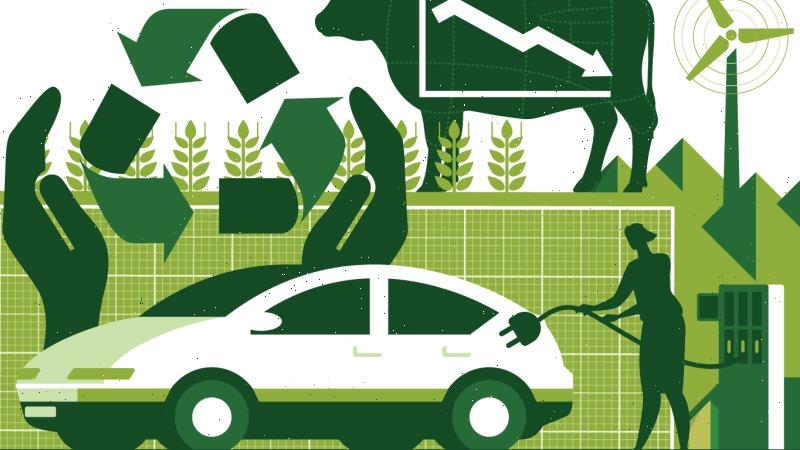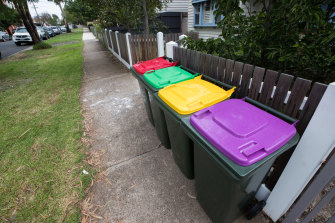By Henrietta Cook
We now know our influence on the planet will last into geologic time.Credit:iStock
As world leaders debate the best ways for nations to tackle climate change, citizens can feel powerless to do much that makes any difference.
But about 55 per cent of the emissions reductions detailed in the International Energy Agency’s roadmap for reaching net zero carbon emissions by 2050 are linked to consumer choices.
Whether it’s ditching gas and fitting homes with energy-efficient technologies, swapping petrol-guzzling cars for electric vehicles, scaling back on meat consumption or recycling, every consumer has the power to reduce their emissions.
We’ve had a look at some of these changes and ranked their effectiveness.
1. Invest in an electric car
Behyad Jafari bought his first electric vehicle five years ago and hasn’t looked back. Since making the switch, he hasn’t spent a cent on mechanics and charging his car battery every fortnight costs virtually nothing.
“It’s so cheap that I can’t identify any change to my electricity bills,” the chief executive of the Electric Vehicle Council said.
Vehicle fuels are the biggest contributor of household emissions, according to a recent report by energy non-profit group Rewiring Australia, which found petrol and diesel make up 69 per cent of a home’s energy use. This is because car engines are only about 30 per cent efficient at converting petrol or diesel to power. Electric cars are a lot more efficient, with those running on solar or other renewable energy sources using 25 to 35 per cent of the primary energy of their petrol-guzzling alternatives.
“The easiest way for an individual to reduce their emissions is to cut out petrol or diesel cars,” Mr Jafari said.
Australia is lagging behind the rest of the world when it comes to electric vehicle sales.
Just 1.5 per cent of all new cars sold last year, or around 6700 vehicles, were electric. This compares with about 17 per cent of all car sales in the UK and 77.5 per cent of new car registrations in Norway.
The industry has previously struggled in Australia due to the lack of aggressive government market interventions such as rebates. As a result, Australian consumers do not have access to the same range of electric vehicles as their overseas counterparts, and they are often much more expensive. There are 31 electric vehicle models available in Australia, and just six of these are priced under $60,000.
“The cheapest at the moment is around $42,000,” said Mr Jafari.
“The two big challenges are that we have less volume at those price points and we end up getting fewer models at those price points.”
In a bid to get more electric vehicles on the road, the Victorian government recently introduced a $3000 rebate towards the costs of new electric cars, while the NSW government is set to offer some electric vehicle buyers more than $7000 in direct payments and tax breaks. Both governments are promising access to a much larger network of charging stations.
Australia is one of the last OECD countries without a fuel efficiency standard, a situation that has led to overseas manufacturers offloading their least efficient vehicles here.
“There is also no incentive for these companies to sell electric vehicles to Australian consumers,” Mr Jafari said.
“Companies (that are) operating overseas market their electric vehicles very aggressively because if they don’t sell enough of them, they have to pay penalties.”
2. Ditch gas appliances in the home
It’s been a household staple for decades: keeping us warm, heating our water and powering our stoves.
But gas is now on the decline across Australia due to its rising economic and environmental costs. Natural gas is responsible for about 19 per cent of Australia’s greenhouse gas emissions, according to a 2020 report by thinktank the Grattan Institute.
Space heating consumes about 60 per cent of a household’s gas usage, followed by hot water heating (33 per cent) and gas cooktops (less than 5 per cent).
Tony Wood, the institute’s energy program director, urges those building new homes to install electric appliances such as reverse-cycle air-conditioning which heats and cools, induction cooktops and heat-pump water heaters. Homeowners renovating or replacing old gas appliances should also consider making the switch to electric appliances, according to Mr Wood.
“If you’ve got perfectly good gas appliances, getting new electric ones installed is not a cheap thing to do,” he said. “But if your hot water system gives up and you have to replace it, replace it with an electric one.”
These appliances are generally much more efficient than their gas counterparts, saving households money on their bills and helping the environment.
“Induction cooktops are more than twice as efficient as gas cooktops, reverse-cycle air-conditioners are more than three times as efficient as gas heaters, and heat-pump water heaters are generally four times as efficient as gas water heaters,” the institute’s Flame out: the future of natural gas report found.
But there is a catch. Making the switch from gas to electricity does not necessarily deliver the same environmental benefits to every household.
It depends on whether you have installed rooftop solar panels or live in a state that is renewable-rich, such as South Australia.
The Grattan Institute report found that in Victoria, a state where households are reliant on gas, transitioning from gas to electric appliances will generally increase emissions over the coming decade. This is due to Victoria’s emissions-intensive brown coal power generators.
But the report acknowledged that even in Victoria, electricity is likely to be cleaner than natural gas by 2035 as the power grid is progressively decarbonised.
American-Australian engineer Dr Saul Griffith, who co-authored the recent Rewiring Australia report with the Australia Institute and lives by the mantra “electrify everything”, said Australian households would save $4200 on their energy bills by 2035 if governments assisted them with the cost of adding solar panels and batteries, replacing gas appliances and buying electric cars.
According to Dr Griffith’s modelling, electrifying Australian households would also reduce domestic emissions by around a third.
“It is now well understood that the vaccine for climate change is electrification,” he recently said.
But Energy Consumers Australia chief executive Lyn Gallagher is concerned about the cost of these changes for low-income households. She said renters were at the mercy of their landlords and often stuck with old, inefficient gas appliances.
“At the moment it feels like it’s a wealthy person’s game,” she said. “Are we going to have a bunch of people who have solar, electric vehicles and feel good about themselves and then a third of people living in rental properties or apartments who are demonised because they are still driving petrol vehicles and on the grid?”
“It is now well understood that the vaccine for climate change is electrification.”
She said there were simpler, cheaper changes that consumers could make to reduce their carbon footprint such as using the cold wash setting on their washing machine and insulating their homes with batts in the ceiling, thick curtains or double-glazing.
”It is not the sexy, shiny new tech thing, but it will make a big difference and it will have an impact straight away,” she said. “Insulation leads to a 25 per cent reduction in energy use.“
3. Reduce the meat in your diet
It’s not a statistic to be proud of: Australians have one of the largest per capita dietary environmental footprints in the world.
This is largely due to our insatiable appetite for meat, as the average Australian eats 95 kilograms of meat a year, nearly three times the global average.
Michalis Hadjikakou, a lecturer in environmental science and sustainability at Deakin University, said ruminant animals such as cows and sheep are the worst offenders.
“The feed that they eat stays in their digestive system for a long time and ferments and then produces methane which is a very strong greenhouse gas,” he said.
Dr Hadjikakou, who describes himself as a flexitarian who eats white meat a couple of times a week, advocates for moderation as opposed to elimination. He believes this is less daunting for Australians who have grown up eating meat regularly.
“The big hitter is just moving away from ruminant meat and replacing it with maybe poultry or pork or kangaroo, or even better, replacing it with legumes or vegetables,” he said.
Recent research published in online journal Nature Food reveals that animals account for almost 60 per cent of all greenhouse gases from food production, with beef the top contributor followed by rice, cow milk, pork and chicken meat. Rice finished surprisingly high on the list due to the methane-producing bacteria that flourish in flooded paddies.
But overall, there was a clear difference in emissions between meat and plant production. Producing one kilogram of wheat creates 2.5 kilograms of greenhouse gases, while every kilogram of beef is responsible for 70 kilograms of emissions.
Cutting down on food waste and only buying what you need can also make a significant difference while steering clear of too much processed food is also beneficial.
Chocolate, for instance, relies on cocoa that is harvested in parts of the world with concerning rates of deforestation.
Eating seasonal, local produce reduces food miles, but Dr Hadjikakou says while this reduces a person’s carbon footprint, it does not make a massive change.
“What you eat makes more of a difference than whether it’s sourced locally,” he said.
4. Switch banks and superannuation funds
Most Australians don’t think about the environmental impact of their banking choices. They probably should.
Australia’s big four banks – Westpac, National Australia Bank, ANZ and Commonwealth Bank – loaned more than $7 billion to expansionary fossil fuel projects between 2016 and 2019, according to an analysis by environmental activist group Market Forces.
The group believes that shifting to a bank or superannuation fund that doesn’t invest in fossil fuel projects is one of the most powerful actions consumers can take to reduce carbon emissions.
“People are increasingly disillusioned with government inaction on climate change and are looking for other ways to make a difference,” said Jack Bertolus, a campaigns coordinator at Market Forces.
“Consumers should really be asking themselves whether they want to support and bank with institutions that are funding expansions of the fossil fuel industry. We know it is incompatible with key climate targets.”
Market Forces encourages consumers to first put their bank or superannuation fund on notice and tell them why they are taking their business elsewhere. It publishes a list of banks and superannuation funds that have steered clear of fossil fuel projects to help consumers switch to more environmentally friendly options.
How do you measure the impact of making this change?
Last year, more than 10,000 Australian academics and university staff, including prominent philosopher Peter Singer, signed a petition urging superannuation fund Unisuper to divest from companies they claimed were incompatible with the Paris climate agreement. Following this campaign, which was initiated by Market Forces, Unisuper abandoned its investments in ASX-listed coal miners New Hope and Whitehaven Coal.
While some consumers with mortgages might be worried about the safety of their loan with smaller lenders, money educator and consumer advocate Nicole Pedersen-McKinnon believes the risk is minimal.
“Small banks, credit unions and building societies are still regulated by the [Australian Prudential Regulation Authority],” she wrote in The Age and Sydney Morning Herald. “Plus the worst-case scenario’s not that bad when YOU owe the money. A small lender goes bust, someone buys their loan book (you can guarantee it) and hikes your rate (also guaranteed) … and you just walk.”
5. Recycling has little to do with climate change
Wheeling out the recycling bin is a weekly ritual across Australia, but does it really make a difference?
While recycling can reduce carbon emissions and is relatively easy for consumers, experts say it is not among the most important climate change initiatives.
“Recycling won’t have a huge bearing on your climate change impact,” says Dr Simon Lockrey, a sustainability and innovation researcher at RMIT University.
“It gives you a warm fuzzy feeling and is an easy thing to participate in. But recycling is less about climate change and more about material efficiency and valuing materials for longer.”
A better alternative to recycling, according to Dr Lockrey, is avoiding single use plastics and unnecessary packaging and investing in reusable, durable products that can be repaired.
“It gives you a warm, fuzzy feeling and is an easy thing to particpate in.”
About 20 per cent of what we put in the recycling bin ends up in landfill, according to a recent report by government agency Sustainability Victoria. It’s estimated this holds true for most of Australia.
According to the agency, there has been an increase in kerbside recyclables being sent to landfill during the pandemic due to more people ordering takeaway and putting their contaminated waste in the wrong bin.
Even though most Australian households have several recycling bins, people put the wrong things in the wrong bins.Credit:Jason South
Boomerang Alliance director Peter Angel says producers have made it incredibly confusing for consumers to know what to put in the recycling bin.
“We were recently looking at a package of bamboo forks and they had four different labels explaining how four different parts of the package were or were not recyclable,” he said.
He said “rough and ready” kerbside collection practices needed to be improved to make recycling more effective. Lumping all recycling in the same bin can lead to contamination, and it’s best if glass, paper, metals and plastics are collected separately.
Mr Angel advises consumers to return their soft plastics to the supermarket and to use social media to hold producers to account for using excessive packaging.
He’d also like to see new recycled content rules, which exist overseas and set a mandated amount of recycled content that producers must use in their products.
“There’s not a lot of coinage investing in collection infrastructure unless there is a market for recyclables to be made into new products,” he explained.
But consumers should not completely despair of their recycling efforts.
In 2015, RMIT researchers Andrew Carre and Dr Enda Crossin assessed the environmental impacts of domestic kerbside recycling and found that the average Victorian household saved 250 kilograms worth of greenhouse gas emissions every year by recycling. This amounted to turning off their electricity for two weeks.
The researchers found that while the benefits of recycling soft plastics were marginal, it was beneficial to recycle old-school materials such as metals and glass.
Most Viewed in National
Source: Read Full Article


